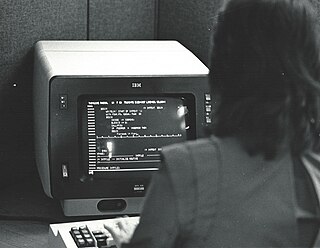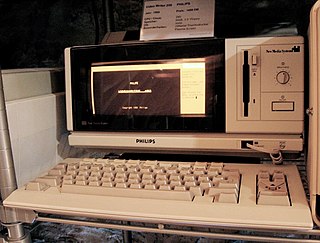
Lotus 1-2-3 is a discontinued spreadsheet program from Lotus Software. It was the first killer application of the IBM PC, was hugely popular in the 1980s, and significantly contributed to the success of IBM PC-compatibles in the business market.

A text editor is a type of computer program that edits plain text. An example of such program is "notepad" software. Text editors are provided with operating systems and software development packages, and can be used to change files such as configuration files, documentation files and programming language source code.

vi is a screen-oriented text editor originally created for the Unix operating system. The portable subset of the behavior of vi and programs based on it, and the ex editor language supported within these programs, is described by the Single Unix Specification and POSIX.

WordPerfect (WP) is a word processing application, now owned by Alludo, with a long history on multiple personal computer platforms. At the height of its popularity in the 1980s and early 1990s, it was the market leader of word processors, displacing the prior market leader WordStar.

WordStar is a discontinued word processor application for microcomputers. It was published by MicroPro International and originally written for the CP/M-80 operating system (OS), with later editions added for MS-DOS and other 16-bit PC OSes. Rob Barnaby was the sole author of the early versions of the program.
Lotus Symphony was an integrated software package for creating and editing text, spreadsheets, charts and other documents on the MS-DOS operating systems. It was released by Lotus Development as a follow-on to its popular spreadsheet program, Lotus 1-2-3, and was produced from 1984 to 1992. Lotus Jazz on the Apple Macintosh was a sibling product.
Job Access With Speech (JAWS) is a computer screen reader program for Microsoft Windows that allows blind and visually impaired users to read the screen either with a text-to-speech output or by a refreshable Braille display. JAWS is produced by the Blind and Low Vision Group of Freedom Scientific.

XEDIT is a visual editor for VM/CMS using block mode IBM 3270 terminals.

AlphaSmart, Inc., formerly Intelligent Peripheral Devices, Inc., was an education technology company founded in 1992 by Apple Computer engineers Joe Barrus and Ketan Kothari, and Kothari's brother, Manish Kothari. At the time of their initial release in 1993, the first AlphaSmart models were marketed as smart keyboards designed to promote writing in the classroom as an alternative to expensive computer labs. The units' durability, long battery life, and limited functionality made them ideal for K-12 classrooms. Later models expanded functionality to spell-checking, running applications, and accessing wireless printers.
Cut & Paste is a word processor published in 1984 for the Apple II, Atari 8-bit computers, Commodore 64, IBM PC compatibles, and IBM PCjr. It is one of the few productivity releases from game developer and publisher Electronic Arts, along with the contemporaneous Financial Cookbook. In the UK it was distributed by Ariolasoft.
Sprint is a text-based word processor for MS-DOS, first published by Borland in 1987.
Q&A was a database and word processing software program for IBM PC–compatible computers published by Symantec and partners from 1985 to 1998. It was written by a team headed by Symantec founder Dr. Gary Hendrix, Denis Coleman, and Gordon Eubanks.

Scripsit is a word processing application written for the Radio Shack TRS-80 line of computers. Versions were available for most if not all computers sold under the TRS-80 name, including the TRS-80 Color Computer and several pocket computer designs, as well as the Tandy version of the Xenix operating system. Tandy Corp. also produced a version running under MS-DOS for its line of PC compatible computers. Some of the 8-bit versions are tape-based and have no ability to read or write to disk.
Screenwriting software are word processors specialized to the task of writing screenplays, i.e. screenwriting.
Emacs, originally named EMACS, is a family of text editors that are characterized by their extensibility. The manual for the most widely used variant, GNU Emacs, describes it as "the extensible, customizable, self-documenting, real-time display editor". Development of the first Emacs began in the mid-1970s, and work on GNU Emacs, directly descended from the original, is ongoing; its latest version is 29.4 , released June 2024.
Apple Writer is a discontinued word processor for the Apple II family of personal computers. It was created by Paul Lutus and published in 1979 by Apple Computer.
Protext is a British word processing program, developed by Arnor Ltd, of Peterborough in the decade following 1985. Originally written for the Amstrad CPC 464, it was later sold for the Amstrad PCW series of word processors, for MS-DOS based PCs, the Atari ST, and the Commodore Amiga.

1st Word is a word processor program for the Atari ST developed by GST Computer Systems and published in 1985. It was given away with all ST systems from December 1985 for the next two years. Although it was relatively well received, it was a very simple program, lacking most power features and was very slow when working in large documents. In spite of any limitations, its wide availability made the program's .DOC file format became a de facto standard for the platform and was widely supported by other programs like desktop publishing systems.

The first version of Microsoft Word was developed by Charles Simonyi and Richard Brodie, former Xerox programmers hired by Bill Gates and Paul Allen in 1981. Both programmers worked on Xerox Bravo, the first WYSIWYG word processor. The first Word version, Word 1.0, was released in October 1983 for Xenix, MS-DOS, and IBM; it was followed by four very similar versions that were not very successful. The first Windows version was released in 1989, with a slightly improved interface. When Windows 3.0 was released in 1990, Word became a huge commercial success. Word for Windows 1.0 was followed by Word 2.0 in 1991 and Word 6.0 in 1993. Then it was renamed to Word 95 and Word 97, Word 2000 and Word for Office XP. With the release of Word 2003, the numbering was again year-based. Since then, Windows versions include Word 2007, Word 2010, Word 2013, Word 2016, and most recently, Word for Office 365.

The Philips/Magnavox VideoWriter is a standalone, fixed-application, electronic typewriter / dedicated word processor produced by Philips Home Interactive Systems (PHIS), a division of the Dutch electronics company Philips. It includes a 10" CRT amber screen with a wide aspect ratio, a black and white thermal transfer printer, a 3.5" floppy drive for saving documents, and dedicated computing hardware, all enclosed in a single case. The keyboard is separate and a custom design whose unusual features include a STYLE key and not just an UNDO key but also a DO key. The VideoWriter is not a freely programmable computer but a typewriter replacement appliance. It is not a laptop machine but was designed to be transportable in either a cloth or hard plastic carry case accessory.










